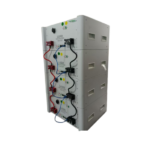
Energy Storage Installation Environment
The installation environment of energy storage systems is crucial for their performance, safety, and service life. The following provides a detailed introduction to the suitable installation environment for energy storage systems from multiple aspects:
1.Temperature
The batteries in energy storage systems are sensitive to temperature. Generally speaking, the suitable working temperature for lead-acid batteries is between 5 ℃ and 35 ℃, while the suitable working temperature for lithium batteries is usually between -20 ℃ and 50 ℃. Excessive temperature may cause battery overheating, accelerate battery aging, and even pose safety hazards; If the temperature is too low, it will affect the charging and discharging efficiency and performance of the battery, and reduce the battery capacity. Therefore, the installation environment should have good temperature control measures, such as air conditioning, ventilation equipment, etc., to maintain a suitable temperature range.
2.Humidity
The relative humidity should be maintained within an appropriate range, generally recommended between 20% and 90%, and there should be no condensation phenomenon. Excessive humidity may corrode batteries and electrical components, reduce insulation performance, and increase the risk of short circuits; Low humidity may generate static electricity, causing damage to electronic devices. Dehumidification equipment can be installed in environments with high humidity; In a dry environment, consider using a humidifier or taking anti-static measures.
3.Ventilate
Good ventilation is necessary to ensure that the heat generated by the energy storage system during operation can be dissipated in a timely manner. Especially during the charging and discharging process, batteries generate a certain amount of heat. If heat accumulates, it can affect system performance and lifespan. The installation location should be equipped with ventilation openings or ventilation systems to ensure smooth air circulation. At the same time, it is necessary to avoid installing energy storage systems in poorly ventilated enclosed spaces.
4.Installation location
Indoor: Choose to install in a dry, clean, and non corrosive gas room, avoiding direct sunlight. The room should have sufficient space for the installation, maintenance, and repair of equipment. The ground should be flat, sturdy, and able to withstand the weight of the energy storage system. In addition, stay away from water sources and flammable and explosive materials.
Outdoor: If installed outdoors, a specialized protective casing or container must be used, which has good waterproof, sunscreen, dustproof, and anti-theft functions. The protection level should generally reach IP54 or above. At the same time, the bearing capacity of the ground and the stability of the foundation should be considered to ensure that the energy storage system can still operate safely under adverse weather conditions.
5.Altitude
The altitude has a certain impact on the performance of energy storage systems. As the altitude increases, the air becomes thinner and the heat dissipation efficiency decreases, which may lead to equipment overheating. Generally speaking, the suitable installation altitude for energy storage systems is below 1000 meters. Beyond this altitude, special design or derating of the equipment may be required, and additional heat dissipation measures may be taken.
6.Electromagnetic environment
Keep away from strong electromagnetic interference sources such as large motors, transformers, radio transmission towers, etc. Strong electromagnetic interference may affect the control circuits and communication systems of energy storage systems, leading to unstable system operation or malfunctions. During installation, it is necessary to ensure that the energy storage system maintains a sufficient safe distance from these sources of interference, or take effective shielding measures.
7.Fire prevention measures
The energy storage system should be installed in an area with good fire resistance, and fire extinguishing equipment such as fire extinguishers and fire extinguishing systems should be equipped around it. Fire alarm devices should be installed inside the battery compartment to promptly detect fire hazards and take measures. At the same time, it is necessary to ensure that the fire exits in the installation area are unobstructed, facilitating the evacuation of personnel and firefighting rescue in emergency situations.

